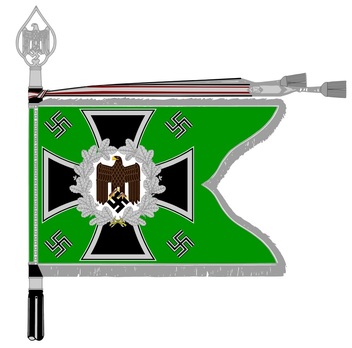German Army General Army Unit Flag (Mountain troops Motorized and Mounted version)
CATEGORY: Version
SKU: 20.GOR.05.018.006
Estimated market value:

Estimated market value:
The flags of the Wehrmacht were initially the old tradition flags of the Imperial Army, which had also been the flags of the Reichswehr. New Wehrmacht flags were introduced on March 16, 1936. All individual colours of units were replaced by the Reich War Flag on August 28, 1944.
Flags and pennants were not only used for individual units, but also to identify high-ranking officers or command posts. Staff flags for commanding officers of units usually showed numbers and (Latin) letters, at least in times of peace, to help identify units more accurately.
There are also National Insignia Pennants (Hoheitszeichen) for officers that were used exclusively on motor vehicles.
The flags of foot units were square, while those of motorized and mounted units were rectangular standards with a so-called “swallow tail”, a cut-out wave-edged section in the fly. The flag’s colour was representative of the branch colour of the unit.
The flag shows four swastikas around an Iron Cross with a superimposed eagle sitting on a swastika inside a wreath of oak leaves. Obverse and reverse are identical, with the eagle being mirrored.
Branch colours on German Heer headgear was as follows:
Black was worn by Engineer units.
Black/White was worn by Panzer Engineers.
Copper Brown was worn by Motorcycle personnel.
Light Brown was worn by Signals units until 1936, and by Construction troops.
Carmine was worn by the Führer Staff, General Staff Officers, Staff Officers of the Supreme Command of the Army, and all Veterinary branches.
Bordeaux Red was worn by Smoke & Chemical personnel.
Wine Red was worn by Judicial officials.
Bright Red was worn by Generals, Artillery units, and Ordnance Officers (until 1944).
Rose or Pink was worn by all Armored units (including Panzer troops, and Schützen Brigade Staff).
Orange was worn by Recruiting personnel, Ordnance troops, Ordnance Officers (since 1944), and Field Gendarmerie units.
Bright yellow was worn by Cavalry units, and Light Division Staff.
Lemon yellow was worn by Signal units.
White was worn by Infantry units.
Light Grey was worn by Propaganda personnel.
Grey-Blue was worn by Sonderführer (Specialist Officers).
Violet was worn by Chaplains and Field Bishops.
Cornflower Blue was worn by Medical units, and Supply units.
Bright Blue was worn by Transport troops.
Bright Green was worn by Jäger and Mountain units.
Grass Green was worn by Panzer Grenadier units (Armored Infantry).
Dark Green was worn by Administrative personnel.
This list gives a broad and somewhat simplified overview, since the branch colour system got more and more complex between 1936 and 1943. Also, different shades were produced due to varying dye lots and production processes.

Comments
Sign in to comment and reply.


Scroll Top